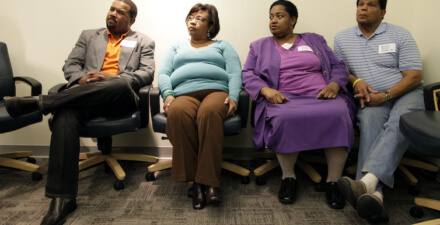Factsheet: U.S. occupational segregation by race, ethnicity, and gender

Overview
Occupational segregation is defined as a group’s overrepresentation or underrepresentation in certain jobs or fields of work. This factsheet elaborates on how occupational segregation in the United States has contributed to lower wages for workers along lines of race and gender and, in turn, contributed to broad wage inequality in the entire U.S. labor market. Furthermore, evidence suggests that the overrepresentation of marginalized groups of workers in occupations reduces their wages irrespective of other measures of productivity such as required skill level, and that integration across occupations has stalled out for Black and Latinx workers.
In the United States, job stratification along the lines of race, ethnicity, and gender impact workers’ labor market outcomes, with groups experiencing compounding privileges or disadvantages due to:
- Occupational crowding
- Devaluation of work
- Uneven occupational integration
- Occupational segregation and recessions
- Occupational segregation, and income and wealth inequality
This factsheet presents evidence in all these categories to demonstrate how occupational segregation entrenches inequality and hurts workers’ labor market outcomes.
Occupational crowding
Occupational segregation lowers wages partly by reducing potential opportunities because it “crowds” marginalized workers into lower-paying jobs. The “occupational crowding” thesis was first developed in 1971 by the late economist Barbara Bergman, who argued that employer discrimination excludes Black men from desirable high-wage jobs for which they are qualified and steers them into lower-paying occupations. This, in turn, raises the supply of workers in those positions, depressing wages and diminishing workers’ bargaining power. In a later study, Bergman found that a similar mechanism impacts women’s labor market standing.
Building on Bergman’s work, economists Darrick Hamilton at The Ohio State University, Algernon Austin at the Economic Policy Institute, and William Darity Jr. at Duke University show that even when accounting for education, Black men are underrepresented in high-wage positions, including most management and professional occupations, and overrepresented in low-wage jobs, particularly in the service sector. Similarly, other studies propose that women’s greater care responsibilities crowds them out of higher-wage positions, since these tend to demand more work hours.
Devaluation of work
When analyzing why jobs with a greater share of women tend to have lower earnings, researchers found that between 1950 and 2000, as the share of women in a given occupation rose, wages in those positions tended to fall. These findings support the “devaluation” hypothesis, which proposes that work predominantly done by women is underpaid. Specifically:
- Even when accounting for factors such as education and work experience, all workers experience an earnings penalty when holding jobs in women-dominated occupations. Black women face the largest penalty, but working in women-led positions hurts the earnings levels of men, women, Asian, Black, Hispanic, and White workers.
- Positions in education provide a good example of this phenomenon. The share of public school teachers who are men fell from 32.2 percent in 1979 to only 24.9 percent in 2018. Research shows that men’s exit from this occupation could reflect a growing wage penalty, where teachers’ earnings have declined relative to comparable workers in other professions.
The devaluation hypothesis appears to be particularly relevant for gendered occupational segregation. So-called caring labor occupations, such as childcare, education, and healthcare where women remain overrepresented, have been shown to have lower wages and compressed wage distributions. This is due, in part, to lower bargaining power among workers, owing to moral commitments and work that is often done collaboratively with long-term, difficult-to-measure benefits.
Occupational integration has been uneven
By many measures, the U.S. labor market is currently less segregated than in previous decades. As the civil rights movement succeeded in removing most formal barriers to employment and education in the 1960s, women’s labor force participation rose, more workers of color were able to access high-wage occupations, and job stratification declined. Greater integration helped narrow gender and racial wage gaps in the second half of the 20th century and had an important effect on many worker’s labor market outcomes. Research estimates that the decline in occupational segregation between 1960 and 2008 explains about 60 percent of real wage growth for Black women, 45 percent for Black men, and 40 percent for White women.
But the decline of occupational segregation has not been constant or equal. Many trends toward greater integration stopped or slowed down in the past few decades, among them:
- Even though millennials (those born between 1981 and 1996) experience less gender-based occupational segregation than Gen Xers (those born between 1965 and 1980) and baby boomers (those born between 1946 and 1964), all three generations face roughly the same level of race-based job stratification.
- Starting in the 1960s, women in general and Black women in particular made big strides toward greater occupational integration as they began to hold more jobs in management, professional, and technical occupations. In the 1980s, however, that progress slowed down, and in 2000, it stopped.
- Within racial and ethnic groups and since the late 1980s, Asian Americans and Pacific Islander men and women have made the greatest progress toward occupational integration, while the opposite is true for Latinx workers.
Occupational segregation and recessions
Economists also find that occupational segregation can become more severe with downturns, as well as help explain why some groups of workers are disproportionately hit by economic crises. Research by Michelle Holder of the City University of New York shows, for instance, that after the Great Recession of 2007–2009, Black men were further crowded out of mid- and high-wage occupations, while men in general experienced a greater spike in unemployment, largely due to their overrepresentation in positions that are more exposed to fluctuations in the business cycle, such as construction jobs.
Kimberly Christensen of Sarah Lawrence College also finds, however, that while women lost jobs at a slower pace than men, the Great Recession led to a shift in women’s occupational structure. As such, a sustained shrinking of the public sector following that recession has had particularly negative consequences for women of color, many of whom went from holding relatively well-paid and secure jobs in the public sector to being disproportionately hired in low-wage jobs in retail, leisure and hospitality, and healthcare.
How occupational segregation contributes to inequality
Occupational segregation explains an important portion of the persisting wage gaps between groups of workers. There are higher racial wage gaps in metropolitan areas with higher Black populations due to discrimination from high-paying jobs, rather than devaluation of jobs associated with Black workers, supporting Bergman’s occupational crowding hypothesis. Evidence from developing countries also finds that crowding of women into particular occupations reduces the overall labor share of income from growth in Gross Domestic Product, so workers are sharing less in economic growth. And occupational segregation not only shrinks immediate earnings but also harms workers’ job security, career advancement opportunities, and ability to accumulate and hold on to wealth.
Conclusion
The sorting of workers in the United States into different jobs along the lines of race, ethnicity, and gender remains one of the most pervasive features of the U.S. labor market. It also is important to note that this factsheet does not document the full extent of occupational segregation, with research showing that there is significant stratification along the lines of sexuality, language, and citizenship status. Limiting the opportunities of workers from marginalized backgrounds maintains wage inequality, further limiting economic security, and constrains the potential of our economy.







